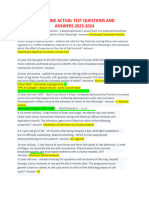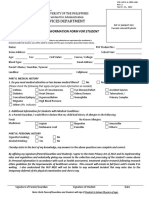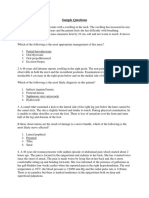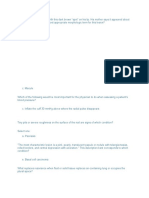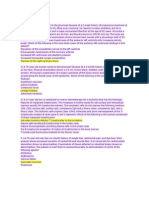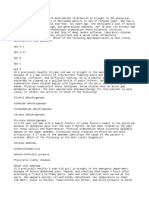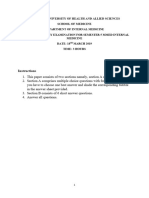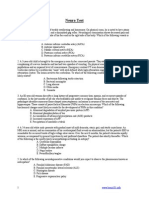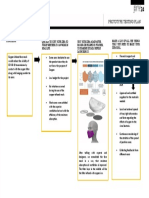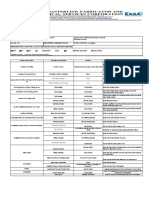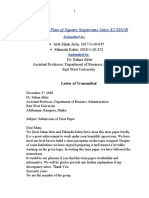0 ratings0% found this document useful (0 votes)
54 viewsStroke
Stroke
Uploaded by
ezar Al barraqA 53-year-old man is suffering from anxiety and conflict at work that may be clinical depression; a 17-year-old boy has blurred vision that reveals 6/18 visual acuity in both eyes; a 56-year-old man had a stroke affecting the right cerebral hemisphere and right middle cerebral artery.
Copyright:
© All Rights Reserved
Available Formats
Download as DOCX, PDF, TXT or read online from Scribd
Stroke
Stroke
Uploaded by
ezar Al barraq0 ratings0% found this document useful (0 votes)
54 views9 pagesA 53-year-old man is suffering from anxiety and conflict at work that may be clinical depression; a 17-year-old boy has blurred vision that reveals 6/18 visual acuity in both eyes; a 56-year-old man had a stroke affecting the right cerebral hemisphere and right middle cerebral artery.
Original Description:
Original Title
A 53
Copyright
© © All Rights Reserved
Available Formats
DOCX, PDF, TXT or read online from Scribd
Share this document
Did you find this document useful?
Is this content inappropriate?
A 53-year-old man is suffering from anxiety and conflict at work that may be clinical depression; a 17-year-old boy has blurred vision that reveals 6/18 visual acuity in both eyes; a 56-year-old man had a stroke affecting the right cerebral hemisphere and right middle cerebral artery.
Copyright:
© All Rights Reserved
Available Formats
Download as DOCX, PDF, TXT or read online from Scribd
Download as docx, pdf, or txt
0 ratings0% found this document useful (0 votes)
54 views9 pagesStroke
Stroke
Uploaded by
ezar Al barraqA 53-year-old man is suffering from anxiety and conflict at work that may be clinical depression; a 17-year-old boy has blurred vision that reveals 6/18 visual acuity in both eyes; a 56-year-old man had a stroke affecting the right cerebral hemisphere and right middle cerebral artery.
Copyright:
© All Rights Reserved
Available Formats
Download as DOCX, PDF, TXT or read online from Scribd
Download as docx, pdf, or txt
You are on page 1of 9
1. A 53-year-old man consults you complaining of anxiety.
He is off sick and fearful of
returning to work - he is in conflict with his managers. You wonder if he is suffering
from clinical depression.
2. A 17-year-old boy presents with blurred vision while reading a text on the whiteboard
from the back row in his class. Ophthalmic examination reveals visual acuity 6/18 in
both eyes. What is the meaning of this visual acuity result?
3. Male 56-year-old had brought to the ER with Loss consciousness. 4 hours
before admission when he was jogging, suddenly he felt weakness on the
right extremity, stutter speech and deviating mouths corner. Headache and
vomiting were present, after that he became unconscious and snoring. Vital
signs are: Consciousness: sopor; BP: 210/130 mmHg; P: 88 x/m; R: 24 x/m
cheyne – stoke type; T: afebris. Neurological Examination: anisocor pupil,
Right CN VIII, Right hemiparesis, Babinsky reflex +/+. What blood vessel is
most likely affected by the injury?
4. Physical examination of a 60-year-old man diagnosed as stroke reveals an inability to
elevate the eye. Which of the following nerve is the likely altered?
5. Occasionally a small portion of Rathkes pouch persists in the roof of the pharynx as a
pharyngeal hypophysis. An hypophyseal defect arise from remnants of Rathkes
pouch. They may form within the sella turcica or along the stalk of the pituitary but
usually lie above the sella, and may cause hydrocephalus and pituitary disfunction;
diabetes insipidus and growth failure. Which of the following defects is the most
appropriate to be above?
6. A 5-year-old male presented to an emergency room with a 3-day history of left ear
pain. Three days before he started to have an upper respiratory infection. On
physical examination revealed an alert boy with a temperature of 39° ~ Left tympanic
membrane is bulging with middle ear suppuration. A 5-year-old male presented to an
emergency room with a 3-day history of left ear pain. Three days before he started to
have an upper respiratory infection. On physical examination revealed an alert boy
with a temperature of 39° C. Left tympanic membrane is bulging with middle ear
suppuration. The hearing test on left ear for the boy above should revealed :
7. A 3.5 kg baby girl was delivered by cesarean section has a severe NTD in
which neural tissue and / or meninges protude through a defect in vertebral
arches and skin to form a cystlike sac, most lie in the lumbosacral region and
result in neurological deficits. Which of the following is likely the most
diagnosis?
8. A 73-year-old woman is brought by her family to the hospital for a vision problem.
The thorough examination hypothesizes a cerebrovascular damage in the right visual
cortex. Which artery that primarily supplies the damaged area?
9. A 30-year-old man with morphine intoxication was treated with naloxone
injection. What is he most likely sign that should be monitored during this
therapy?
10. The specific neurotransmitter deficit associated with Alzheimers disease was
reduced amount of acetylcholine in nerve terminals in cortical region due to
degeneration of cholinergic neurons in the basal forebrain. Which of the followings
best explains the above neurotransmitter?
11. A 24-year-old man presents to you with longstanding low mood and problems at
work. He tells you that he has been spending excessive time on the internet at work
and has been disciplined for this. He is frustrated with himself, also sad and guilty.
He is a perfectionist with work tasks and tends to avoid them by going on the internet
and eating chocolate.
What is the most likely underlying problem to evaluate in further history taking?
12. 25-years-old, male admitted to the hospital due to fever and lost of consciousness.
The doctor in charge was suspected the patient with infection process in his brain or
meningeal layer. Then, the patient was taken for the Cerebrospinal Fluid (CSF) to
determine the etiology of his symptoms.
The routine CSF examination was done and the result as bellow:
Macroscopy :colorless, turbid
Cell count :Increase
Differential count:
PMN :80%
MN :10%
Nonne test :Positive
Pandy test :Positive
Glucose :Decrease, less than 50% compare with plasma glucose
Protein :Increase
According to the history taking and result of routine CSF examination, what is the
most indicated etiology for this patient?
13. A 21-year-old man was brought to the emergency room with complaint of agitation
and massive sweating. After thorough history taking and physical exam the patient is
diagnosed as addiction. Which of the most important neurotransmitter is altered in
thisi patient?
14. 25-years-old, male admitted to the hospital due to fever and lost of consciousness.
The doctor in charge was suspected the patient with infection process in his brain or
meningeal layer. Then, the patient was taken for the Cerebrospinal Fluid (CSF) to
determine the etiology of his symptoms.
The routine CSF examination was done and the result as bellow:
Macroscopy :colorless, turbid
Cell count :Increase
Differential count:
PMN :80%
MN :10%
Nonne test :Positive
Pandy test :Positive
Glucose :Decrease, less than 50% compare with plasma glucose
Protein :Increase
What is the most correct reason the protein increase in the CSF?
15. A patient presented with loss of visual field involving the upper left visual field in both
eyes.
Where is the most likely location of the lesion?
16. You have the ability to identify the value of unseen coins in your pocket as
you handle them.
This ability is depended on the intact of the following tract?
17. A 3.8 kg baby boy was delivered by cesarean section has occipitofrontal
circumference at birth was 39.5 cm. He is suffering from an obstruction of the
aquaduct of Silvius, as a result, the CSF accumulates in the lateral ventricels and
presses on the brain and bones of the skull. Since the cranial sutures have not jet
fused, spaces between them widen as the head expands, and the head may be very
large. Which of the following is the most likely diagnosis?
18. An 18-year-old woman had been referred to unit emergency of RSHS because
worsen of weakness and numbness of the extrimities beginning 7 days ago and no
complaints of urination, defecation, no double vision, no mouth asymmetry nor
difficulties in breath. Which of the following level of the Nervous System the
symptoms related?
19. A 40-year-old lady presents with multiple somatic symptoms in various parts of her
body of 15 years duration. Repeated medical investigations have not revealed any
organic basis for her symptoms. During the interview, you notice that she is very
critical of doctors and she accuses them of failing to diagnose her illness.
Which one of the following is the most likely diagnosis?
20. A 65-year-old man came to the hospital with complain of hearing loss on the left ear
since 4 months ago. Which is the best exam for predicting the type and degree of
hearing loss?
21. A 41-years-old woman complains of diminished hearing on the left for several month.
A head CT scan shows a sharply circumscribed, 4cm mass located adjacent to the
left pons that extends into left inferior cerebellar hemisphere. This lesions is most
likely:
22. A 20-year-old female, admitted in Hospital came with unconscious due to motor cycle
accident. His hand is decortications, his voice is mumble and his eye closed with pain
stimuli. How many is the GCS score in this patient?
23. A 4-year-old child has suffered a global neurodevelopmental insult from viral
encephalitis in the neonatal period. You are asked to assess his neurodevelopmental
age from the following observations:
He drinks from a cup but is unable to wash his hands.
He scribbles but cannot draw a line.
He has 3 words.
He walks but cannot run.
24. A patient on routine physical examination is found to have an area of anesthesia on
the face extending from the midline to a line drawn approximately from the right
nostril upwards past the lateral canthus of the right eye to the top of the skull.
Which of the following has most likely been injured?
25. TheMRI of a 70-year- old man shows an infarcted area in the medial medulla at a
mid olivary level on the left. This correlates with a loss of position sense from the
mans upper right extremity. Which of the following represents the location of the cell
bodies of origin of those fibers damaged in this patient in the medulla?
26. The coronal MRI of a 2-year-old child shows a 2.0 cm diameter tumor in the rostral
tip of the temporal ( inferior) horm of the lateral ventricle. It is possibly arising to the
hippocampus, this tumor is most likely impinging on which of the following
structures?
27. A 18- months-old toddler was brought by his mother to the clinic with speech delay.
On ENT examination, the results were within normal limits. Which one of the
following risk factor is most likely?
28. A 65-year-old male come with hearing impairment since 6 months ago. From history
taking, the patient does not have hearing loss risk factor. Physical examination
revealed no cerumen from both ear. Which one of the following is the most likely
occur?
29. A 20-year-old man presents with a 2-day history of headache, skin rash and
photophobia. A lumbar puncture reveals polymorph leukocytosis and low glucose in
the cerebrospinal fluid.
Such findings are compatible with:
30. The light reflex examination of this patient shows no abnormality. Which of the
following cranial nerve function is being examined?
31. Which of the following aspect is directly related to the speed when a myelinated axon
conducts an action potential?
32. A 30-year-old woman came to clinic with right aural fullness since 3 days. From
history taking, she has had cough and rinorrhea since 1 week. Physical examination
revealed no cerumen from both ear. Which one of this following is the most likely to
occured in tuning fork examination?
33. Please refer to the picture above: If the problem is located at number three, which of
the following is the correct defect of the visual field?
34. A 20-year old university student was brought to the hospital and diagnosed with
Guillain Barre Syndrome. She was treated with a series of intravenous
immunoglobulin in the ICU. One week prior to the hospital admission, she
experienced diarrhea and upper respiratory tract infection. After being treated for 10
days, she recovered well without sequel. What is the most likely type of peripheral
nerve disease does this patient have?
35. A 42-year-old male, had visited the ophthalmologist with the chief complain of watery
discharge from both eyes, which become puffy and red.
What is the most likely microorganism cause of infection in this patient?
36. A 28-year-old man came to the GP due to severe restlessness, anxiety, and
generalized myalgia for the past three days. He also complained of lack of sleep for
the past two days. Physical examination showed dilation of the pupils, excessive
lacrimation, diaphoresis, and piloerection. He was suspected to have withdrawal
symptom due to drug ingestion. Which of the following drug is most likely used?
37. A previously well female aged 32 presents with a severe generalised headache. It
came on suddenly 3 hours ago. She has vomited once since the onset. On
examination the only abnormal findings are photophobia, ptosis of one eyelid, and
moderate neck stiffness.
Which of the following diagnoses are most likely?
38. Loss or blockage of GABA inhibition play a role in the development of seizure.
Which one of the following statements is most likely the metabolic pathway of the
above neurotransmitter?
39. A 70-year-old man was diagnosed of having medulablastome. Which of the following
cells is the largest cell in that injured organ?
40. A colleague of yours states that he has been having headaches. These have a
throbbing quality and are usually unilateral and preceded by visual blurring and
teichopsia. He has recently broken off an engagement.
The diagnosis is likely to be:
41. A 20-year-old male came to primary health center with the chief complain of
difficulties in distance reading. The visual acuity of the right eye is 6/20 and for the
left eye he could not read the biggest letter of the Snellen chart. After refraction
examination, with S -0,75 D the visual acuity for the right eye become 6/6, and with S
– 1,00 D C -0,50 x 90o the visual acuity become 6/6. What is the appropriate
diagnosis for the right eye?
42. A 3-month-old baby is brought to her pediatrician for a check up. Stroking the plantar
surface of the foot produces a reflex extension of the large toe rather than expected
lesion. This reflex sign elicited by the physician indicate damages to which of the
following?
43. In the development of seizures, there is an abnormal and excessive firing of the
excitatory and inhibitory neurotransmitters. The excitatory neurotransmitter involved
is classified into the following:
44. A neurologist sees a 29-year-old woman who complains a slowly progressive loss of
vision on her right side affecting both eyes. A CT scan demonstrates a high-density
space-occupying lesion. The lesion produces visual field defect by compressing
which structure?
45. A 22-year-old female takes a diet supplements containing ephedrine. Activation of
the sympathetic nervous system by ephedrine causes tachycardia and palpitation.
Which of the following smooth muscle that also contracts?
46. A 10-year-old girl was taken to the emergency room after accidently ingesting some
amounts of amphetamine. What is the most likely clinical presentation in this girl?
47. A 30-year-old previously healthy woman presented with sudden loss of
consciousness. The most important question to ask in order to determine the cause
is:
48. In a winter day, a 55-year-old man suddenly feels pain and tingling noise in
his left ear and weakness in moving his lips and closing his eye on the left
side. His doctor wants to carry out a simple test to ensure that it is a common
neurological condition.
What would be the most appropriate diagnostic test?
49. A 3-year-old previously healthy girl has had an uncomplicated febrile seizure. Her
parents are concerned that she may have another febrile seizure causing permanent
brain damage.
50. A right-handed 65-year-woman suddenly feels weakness of her right arm and hand
and subsequently finds that she cannot move them voluntarily. During the
examination she has slow and hesitant speech. She can move her legs normally, her
vision is normal, her finger-to-nose test is normal, and there is no sign of
disequilibrium.
Which of the following arteries is most likely to have been affected?
51. A hypothetical patient has lesions in the left frontal cortex adjacent to the face
region of the motor cortex.
What is the most likely sign and symptom to be expected?
52. You want to examine the function of the hypoglossal nerve of a patient.
What will you ask the patient to do?
53. A radiographic examination reveals an injury of the pyramidal tract anywhere
above the decussation. Which of the following sign is most likely appear?
54. A 68-year-old man presents with a chief complaint of night blindness due to
avitaminosis A, which underlies the impairment of rod function. Which of the
reactions in the retinal rods is caused directly by the absorption of light
energy?
55. A 30-year-old carpenter was brought for psychiatric evaluation. He claimed that he
was a body guard for the prime minister of an unknown country. He was afraid that
there were policemen who wanted to catch him. What is the most likely
sign/symptom shown by the patient?
56. A 78-year-old man suddenly developed a right-sided hemiplegia. He was unable to
give a satisfactory history because the only words that he could speak were curse
words. He could not respond to the question appropriately.
What other neurological deficit is this patient likely to have?
57. The malformation caused by an ossification defect in the bones of the skull, the most
frequently affected bone is the squamous part of the occipital bone, which may be
partially or totally lacking. If the defect is large part of the brain and even part of the
ventricle may penetrate through the opening into the meningeal sac. Which of the
following is likely the most diagnosis?
58. A 22-year-old woman is admitted to hospital in late August with a two day history of
severe headache, low grade fever and mild neck stiffness. The cerebrospinal fluid
analysis results are 110 white cells (90% lymphocytes); protein 0.5 g/L; and glucose
3.3 mmol/L. Blood glucose is 5.4 mmol/L. She is mentally alert and has not received
previous antibiotics.
59. A 38-year-old man describes a persistent fear of speaking in public. Although he
does not have difficulty with one-on-one situations, when giving a lecture he
becomes extremely anxious, worrying that he will be humiliated. He relates one
episode in which he was forced to speak at the last minute, which resulted in his
experiencing panic, shaking, abdominal cramps, and a fear that he would defecate
on himself. Which of the following is the most likely diagnosis?
60. Female, 8 month old, came to pediatric emergency with seizure as chief complain in
1 hour before admission. She had generalized seizure last in 3 minutes. She had
fever (38.50C) since 2 day ago. She looked allert, from physical examination we
found sign of URTI (upper respiratory tract infection), neurologic examination within
normal limit. Her father had seizure during fever when he was a chil~ The most
possible diagnosis in this patient is:
61. A 48-year-old man presented to the emergency unit in Hasan Sadikin Hospital with
extreme salivation, involuntary defecation and urination, bradycardia, and
hypotension. What is the most appropriate drug for life saving therapy for this
patient?
62. A 17-year-old boy is admitted to the hospital with traumatic brain injury after
motorcycle traffic accident. He develops a fever of 39oC, which is unrelated to an
infection or inflammation. Which of the following nervous system lesion in
hypothalamus that altered in this patient?
63. A toddler, 18- months-old was brought by his mother to the clinic with speech delay.
On ENT examination, the results were within normal limits. Which one of the
following is the most appropriate hearing test?
64. A 54-year- old man was diagnosed left Medial Longitudinal fasciculus Lesion based
on his CT scan. Two days before, he was fallen from the ladder about 3 m height. A
slight subarachnoid hemorrhage within bilateral sylvian fissure, but no parenchymal
contusion in the brain stem. What kind of deficit neurologic will occur?
65. A 30-year-old carpenter was brought for psychiatric evaluation. He claimed that he
was a body guard for the prime minister of an unknown country. He was afraid that
there were policemen who wanted to catch him. What is the most likely
sign/symptom shown by the patient?
66. A patient with unconsciousness is hospitalized with symptoms of high fever and
rigidity of the neck. A lumbar spinal tap is performed, and three tubes of CSF are
delivered to laboratory. Later is known, the patient had tuberculosis in the lung. The
neurologist suspects the patient has Tubercular Meningitis.
The result that might be find in the CSF is ….
67. A doctor was performed examination to check reactivity of the pupils using penlight.
When light strikes the eye. Which of the following molecular substance in signal
transduction in the retina normally increase?
68. A man brings his 49-year-old wife to the emergency department. She is dazed,
confused, disorientated, agitated and pacing restlessly. She was well until this
morning, when she heard about her only son being admitted to an intensive care unit
in a critical state following a road traffic accident.
What is the most appropriate treatment to help her cope over the next 48 hours?
69. A roommate of a patient said that he had difficulty in understanding his friends talk.
He noticed that his friend always strayed from the topic and found that it was difficult
to understand. What is the most possible thinking disturbance experienced by this
patient?
70. Taking, she has had cough and rinorrhea since 1 week. Physical examination
revealed no cerumen from both ear.
Where is the location of abnormalities are most likely in this case?
71. A 50-year-old female had loss of partial memory. The MRI shows obstructed vessels
in limbic lobe. Which of the following is the most likely obstructed artery?
72. A girl brought her mother to the doctor for a routine health check and immunization.
Parents said the health of her daughter was fine, only concern that her daughter has
not been smooth limping like her neighbor. Born on August 13, 2010 (weight 2.5 kg,
length 47 cm, head circumference 33 cm) helped by doctors. Aged 36 weeks of
pregnancy. The result in the growth and development clinic on March 18, 2012:
weight 10 kg, length 75 cm, head circumference 43 cm. What would you do next?
73. A 30-year-old unconscious man was brought to the ER for further management. On
examination, he has pin-point pupils with perioral and periungual cyanosis. His
breathing was shallow and about 3-5 times per minute. He responded to sternal rub
only. The most likely drug the patient ingested is:
74. A 6-year-old boy is brought to your office with a complaint of stomach aches. He has
been out of school for the last two weeks. His stomach aches are most troublesome
in the morning.
The most likely cause is:
75. A 18-year-old boy was admitted to Emergency Room of Hasan Sadikin Hospital.
Fifteen minutes before he got traffic accident that caused unconscious. The doctor
found his breath of alcohol. The relative said that he often drink alcohol. Which of the
following sample should be taken to prove alcohol abused?
76. A 58-year-old man with open-angle glaucoma was prescribed pilocarpine ophthalmic
drops. Which of the most appropriate mechanisme about the drug?
77. A 65-year-old man presents with sudden onset of loss of pain and temperature
sensation on the left side of the face and the right side of the body below the head
and upper neck. He also has vertigo and vomiting.
Where is the most likely site of the lesion causing these effects?
78. The MRI of a 66-year-old man shows a tumor 2.0 cm in diameter located in the
lateral wall of the atrium of the lateral ventricle. Which of the following structures does
this lesion most likely damage?
79. A 20-year-old college student was brought to the clinic by his roommate due
to the change in his behavior for the past one month. He has no intention to
talk or socialize even though his friends try to do so. Which sign/symptom is
most likely shown by the patient?
80. A 26 year old heroin drugs addict was brought to the emergency room. He had chills,
runny nose, abdominal cramps, and muscle spasms. His pupils were dilated. His
heart rate and blood pressure were increased. What is the most likely pharmacology
phenomena was he experiencing?
81. A 69-year-old man complains of difficulty walking. The examination reveals no
weakness, but does reveal a loss of discrimination touch and vibratory sense on the
left lower extremity. MRI indicated a small structural alteration in the midbrain. Which
of the following structures is most likely located?
82. Select the most likely level of consciousness of the patient above:
83. A 73-year-old man presents with a three-week history of progressive left-sided
weakness. Examination reveals increased tone, muscle strength grade 4 on the left
side and brisk reflexes in the left upper and lower limbs, with an ipsilateral extensor
plantar response. Sensory testing is normal. He drags the left leg when he walks.
What is the most likely site of pathology?
84. A 45-year-old terminally ill man had been put on the ventilator support in the ICU for
10 days. His family requested to know the prognosis. What is the most likely cardinal
feature for brain death?
85. A 5cm mass beneath dura that compresses the underlying left lateral parietal lobe is
found incidentally on head CT scan performed on 38 years old woman who fell and
hit her hea~ She has taken surgery, and after removal by the neurosurgeon, the
mass in seen histologically to the composed of elongated cells with pale, oblong
nuclei and pink cytoplasm with occasional psammoma bodies. The neoplasm of the
central nervous system (CNS) that best explains these finding is:
86. A 20-year-old male came to primary health center with the chief complain of
difficulties in distance reading. The visual acuity of the right eye is 6/20 and for the
left eye he could not read the biggest letter of the Snellen chart. After refraction
examination, with S -0,75 D the visual acuity for the right eye become 6/6, and with S
– 1,00 D C -0,50 x 90o the visual acuity become 6/6. What is the most appropriate
next step for the left eye?
87. A 14-year-old female was diagnosed as epileptic (tonic-clonic type) and has been
treated with carbamazepin~ She has been poorly compliant with her medications,
and has been rushed to the A/E with status epilepticus.
Which ONE of the following is the MOST APPROPRIATE measure for IMMEDIATE
control of her convulsions?
88. A 43-year-old woman was admitted to Hasan Sadikin Hospital complained of
progressive weakness of the right extremities, she can followed command but
difficult to say words to answer questions. On CT examination there was
contrast enhanced lesion with large edema around the lesion. The most
possible location of the lesion is:
89. You are on the admitting medical team and a 40-year-old woman is admitted with
progressive weakness and tingling of the legs and feet over the last 3 days. She had
flu-like illness with diarrhoea 2 weeks prior to admission, but has otherwise been very
fit in the past. On testing, she has symmetrical weakness and sensory disturbance in
both legs with diminished tendon reflexes and similar, but less marked changes in
her hands and arms.
What is the most likely diagnosis?
90. A 30-year-old woman came to clinic with right aural fullness since 3 days.
From history taking, she has had cough and rinorrhea since 1 week. Physical
examination revealed no cerumen from both ear.Which one of the following is
the most possibility of hearing loss?
91. The drummer of a local band presents to your clinic with hearing loss. Otoscopic
examination reveals loss of contaction of the tensor tympani and the stapedius,
which prevents damage to the eardrum and middle ear ossicles. These muscles are
most likely controlled by which of the following nerves?
92. 43. A 10-year-old male child brought to primary health center by his mother with the
chief complains of sight problem. After thorough eye examination, the diagnosis is
myopia simplex of the both eye. What is the possible complain of the patient?
93. A 73-year-old woman is brought by her family to the hospital for a vision
problem. The thorough examination hypothesizes a cerebrovascular damage
in the right visual cortex. Which of the following symptom is most likely
appear?
94. An 18-year-old woman had been referred to unit emergency of RSHS because
worsen of weakness and numbness of the extrimities beginning 7 days ago and no
complaints of urination, defecation, no double vision, no mouth asymmetry nor
difficulties in breath. Which of the following level of the Nervous System the
symptoms related?
95. Facial nerve may be injured or may become dysfunctional anywhere along its
long course from the brainstem t. o the face. If the patient has loss of taste
over the anterior 2/3 of tongue and excessive sensitive to sound in one ear ,
indicate which level of facial nerve damage?
96. Mr. Dadang, 65-year-old had been diagnosed with infarction stroke and had been
hospitalized for 5 days, 4 weeks ago. He still has communication disorder but still
understand what people said and weakness of right extremities as a sequel. He was
bedridden. He had been diagnosed with hypertension and diabetes mellitus for 15
years ago but he didnt control regularly. He got antihypertension drug from the doctor
after hospitalized and he got it only if there is headache symptom. He always ate
sate kambing in the weekend. He was a retired government officer and had health
insurance. Which of the following is the impact of illness to the family?
97. Which of the following test will confirm your diagnosis?
98. A doctor performed a test with a tuning fork on a 10-year-old boy. He has difficulty in
hearing in his right ear for the last week. He can hear the tuning fork only when it is
placed on his mastoid process. Which of the following structure is the most likely
altered in the transmission of sound waves?
99. A 40-year-old woman presents with gradually blurred vision for the past three
months. She has Diabetes Mellitus since 10 year ago. Ophthalmic examination
reveals visual acuity 6/18 in both eyes; anterior segment examinations are within
normal limit. What is the most appropriate next examination?
100. A 50-year-old female come to primary health center with the chief complain of
sight problem. After thorough examination the refractive correction revealed the
refractive correction of S + 1,00 D for both eyes with Snellen chart exam and S +
1,50 D for both eyes with Jaeger chart exam. What is the possible diagnosis for the
patient?
You might also like
- Nbme Cbse Actual Test Questions and AnswersDocument175 pagesNbme Cbse Actual Test Questions and Answersgithijidennis99100% (1)
- NBME 10 Unsolved QuestionsDocument88 pagesNBME 10 Unsolved QuestionsMisbah Kaleem100% (3)
- NBME26 Q Only - ORCDocument97 pagesNBME26 Q Only - ORCZZ_14U100% (1)
- March 2021 USMLE Recalls Actual Exam Questions: Click To Get MoreDocument8 pagesMarch 2021 USMLE Recalls Actual Exam Questions: Click To Get MoreRushi Shah75% (4)
- USMLE Step 1: Integrated Vignettes: Must-know, high-yield reviewFrom EverandUSMLE Step 1: Integrated Vignettes: Must-know, high-yield reviewRating: 4.5 out of 5 stars4.5/5 (8)
- USMLE Step 3 Lecture Notes 2021-2022: Pediatrics, Obstetrics/Gynecology, Surgery, Epidemiology/Biostatistics, Patient SafetyFrom EverandUSMLE Step 3 Lecture Notes 2021-2022: Pediatrics, Obstetrics/Gynecology, Surgery, Epidemiology/Biostatistics, Patient SafetyRating: 5 out of 5 stars5/5 (2)
- PUP Medical Health Information Form For Students 2022Document1 pagePUP Medical Health Information Form For Students 2022ReineirDuranNo ratings yet
- Sample Questions For Emstrex 2012Document6 pagesSample Questions For Emstrex 2012Dr.2020100% (1)
- Nurse Practitioner Board ReviewFrom EverandNurse Practitioner Board ReviewRating: 5 out of 5 stars5/5 (1)
- Ms Akt Practice Exam Paper 1 RandomisedDocument101 pagesMs Akt Practice Exam Paper 1 RandomisedSpring BlossomNo ratings yet
- Nbme 16 AnsDocument17 pagesNbme 16 Ansnithin shenoi0% (1)
- Rcem Learning FRCEM PRIMARY Paper 3 PDFDocument8 pagesRcem Learning FRCEM PRIMARY Paper 3 PDFsamee0% (2)
- Pedia QuizesDocument19 pagesPedia QuizesPraneeth PaletiNo ratings yet
- Installation of Fire Fighting SystemDocument66 pagesInstallation of Fire Fighting SystemAnandu AshokanNo ratings yet
- FORMATIF NBSS KesekianDocument10 pagesFORMATIF NBSS KesekianCYNTHIA ARISTANo ratings yet
- 5th Sem Internal Mid TermDocument17 pages5th Sem Internal Mid TermIashdip iashdipNo ratings yet
- Original Question Bank, CacesDocument629 pagesOriginal Question Bank, CacesScribdTranslationsNo ratings yet
- Mccee Sae 5Document45 pagesMccee Sae 5Karthikeyan GanapathyNo ratings yet
- MCC SaeDocument98 pagesMCC SaeAllison100% (1)
- CK 9Document11 pagesCK 9nreena aslamNo ratings yet
- Assignment 2nd Year - NEUROANATOMYDocument3 pagesAssignment 2nd Year - NEUROANATOMYNaveed AkhterNo ratings yet
- Prometric MCQS For General Practitioner (GP) Doctor MCQS Exam QuestionsDocument24 pagesPrometric MCQS For General Practitioner (GP) Doctor MCQS Exam Questionsibrahim 12100% (1)
- Self Administered Exam 4Document31 pagesSelf Administered Exam 4priyarajan007100% (4)
- Nbme 15Document52 pagesNbme 15sharrisanyae100% (19)
- AlhamdulillahDocument16 pagesAlhamdulillahhamza ranaNo ratings yet
- Nbme 13Document22 pagesNbme 13Schi WeiNo ratings yet
- Prometric Mcqs For General Practitioner GP Doctor Mcqs Exam QuestionsDocument28 pagesPrometric Mcqs For General Practitioner GP Doctor Mcqs Exam QuestionsDr. Saqib RazaNo ratings yet
- 1 Copy 15Document67 pages1 Copy 15imlegoldstandardNo ratings yet
- File 190 - MoryDocument10 pagesFile 190 - Moryasmaarabee50No ratings yet
- Mmed Semester 5 Ue TheoryDocument12 pagesMmed Semester 5 Ue TheorymussaNo ratings yet
- EMBRYOLOGYDocument4 pagesEMBRYOLOGYbhagavan prasadNo ratings yet
- Case Session 1 Neuro PathologyDocument3 pagesCase Session 1 Neuro PathologyMuzNo ratings yet
- Qstream-1 2Document55 pagesQstream-1 2Vijay100% (1)
- The Anatomy of A Great Poster: Richard Gerkin, M.D. Bridget Stiegler, D.ODocument31 pagesThe Anatomy of A Great Poster: Richard Gerkin, M.D. Bridget Stiegler, D.OFetria MelaniNo ratings yet
- Shanhgai USMLE Final AssessmentDocument12 pagesShanhgai USMLE Final Assessment772450336No ratings yet
- Neuro TestDocument9 pagesNeuro TestHanung Merahbara100% (1)
- Casereport: Vishal Jain, MD, Anagha Deshmukh, MD, Stephen Gollomp, MDDocument4 pagesCasereport: Vishal Jain, MD, Anagha Deshmukh, MD, Stephen Gollomp, MDlionkingNo ratings yet
- Rcem Learning FRCEM PRIMARY Paper 1Document9 pagesRcem Learning FRCEM PRIMARY Paper 1sameeNo ratings yet
- Pre-Intern 2021Document53 pagesPre-Intern 2021Jemima MalaikaNo ratings yet
- Internal Medicine 5th MidtermDocument13 pagesInternal Medicine 5th MidtermIashdip iashdipNo ratings yet
- NBME Sample QuestionsDocument10 pagesNBME Sample QuestionssamNo ratings yet
- Case Report Tuberculous Otitis MediaDocument23 pagesCase Report Tuberculous Otitis MediahwelpNo ratings yet
- Opthalmology Case Summary: Ahmad Sukri Nawi MEM080005 Group 4Document11 pagesOpthalmology Case Summary: Ahmad Sukri Nawi MEM080005 Group 4Matyie SmkasNo ratings yet
- KR 2003Document22 pagesKR 2003ruchipickleNo ratings yet
- Step 2 Medicine - 2023 Training (Base)Document5 pagesStep 2 Medicine - 2023 Training (Base)vulpes.umbriferNo ratings yet
- UK Medical School AKT Practice ExamDocument101 pagesUK Medical School AKT Practice ExamJaundice henryNo ratings yet
- SOAL NO BaruDocument16 pagesSOAL NO Barukautsar abiyogaNo ratings yet
- E92t15 2015EDocument24 pagesE92t15 2015EDr-Mohammad AlfawazNo ratings yet
- ERMP 2021, Part II-1Document16 pagesERMP 2021, Part II-1kude kulayeNo ratings yet
- Advanced Health Midterm AssessmentDocument11 pagesAdvanced Health Midterm Assessmentseansdrew2No ratings yet
- MCQ Neuro SampleDocument12 pagesMCQ Neuro SampleMutiara AdystiNo ratings yet
- Sept Recall PlabDocument19 pagesSept Recall PlabDr-Jahanzaib GondalNo ratings yet
- 5TH September 2020 Plab 1 MockDocument34 pages5TH September 2020 Plab 1 Mockrandom personsaNo ratings yet
- Untitled DocumentDocument16 pagesUntitled Documentclockstudy5No ratings yet
- Medicine OSCEDocument21 pagesMedicine OSCEAakash KsNo ratings yet
- Mock Papers for MRCPI, 3rd Edition: Four Mock Tests With 400 BOFsFrom EverandMock Papers for MRCPI, 3rd Edition: Four Mock Tests With 400 BOFsNo ratings yet
- Adrenal Disorders: Physiology, Pathophysiology and TreatmentFrom EverandAdrenal Disorders: Physiology, Pathophysiology and TreatmentAlice C. LevineNo ratings yet
- Consumer Protection Act (CpaDocument54 pagesConsumer Protection Act (CpaShabeel PnNo ratings yet
- DPT-BSCS Result Sem-1Document3 pagesDPT-BSCS Result Sem-1Rashid MehmoodNo ratings yet
- AD392: History and Theory in Spatial Design: DissertationDocument42 pagesAD392: History and Theory in Spatial Design: DissertationDivya PardalNo ratings yet
- If It'S Tight, It Ain'T Right:: by Doug Kelsey, PT, PDocument33 pagesIf It'S Tight, It Ain'T Right:: by Doug Kelsey, PT, PZendisNo ratings yet
- StarSpecial PostGraduate Aug 18Document8 pagesStarSpecial PostGraduate Aug 18Sym World Advertising Sdn BhdNo ratings yet
- Sample 10 Prototype Testing PlanDocument1 pageSample 10 Prototype Testing PlanGrizelNo ratings yet
- Protocol 005Document18 pagesProtocol 005Abo-ahmed ElmasryNo ratings yet
- Drug Study IsoniazidDocument3 pagesDrug Study IsoniazidJamil Lorca100% (4)
- Unit 13 Managing Human Resources in Health and Social CareDocument4 pagesUnit 13 Managing Human Resources in Health and Social Carechandni0810No ratings yet
- ASSESSMENT TASK 2 NUrsing Management-1-QuinioDocument3 pagesASSESSMENT TASK 2 NUrsing Management-1-QuinioFe Malamal QuinioNo ratings yet
- Levine Sign - Google SearchDocument1 pageLevine Sign - Google SearchMathan KarthikNo ratings yet
- Case - Kanak JaggeryDocument1 pageCase - Kanak JaggeryPALLAVI BHISENo ratings yet
- NCP AppendicitisDocument4 pagesNCP AppendicitisAisha LakibulNo ratings yet
- Gathering Information From SurveysDocument4 pagesGathering Information From SurveysQueenieCatubagDomingoNo ratings yet
- M e Research PaperDocument5 pagesM e Research Paperapi-607357733No ratings yet
- Blue Gold Watercolour Group Project Presentation 20231201 212051 0000.Pptx 20231201 215238 0000Document12 pagesBlue Gold Watercolour Group Project Presentation 20231201 212051 0000.Pptx 20231201 215238 0000NIRAV TAWADIANo ratings yet
- Intravenous FluidsDocument19 pagesIntravenous Fluidsblack pink in ur area 21100% (1)
- Intertwined Movements, Interwoven Histories: HIV & AIDS in TurkeyDocument40 pagesIntertwined Movements, Interwoven Histories: HIV & AIDS in TurkeyGülşah TekinNo ratings yet
- Adv Exp Med Biol 2020 Apr8 Maranta F PDFDocument24 pagesAdv Exp Med Biol 2020 Apr8 Maranta F PDFFernando SousaNo ratings yet
- 19-20 Physical Education Final ExamDocument5 pages19-20 Physical Education Final ExamDeona FayeNo ratings yet
- (Download PDF) The Making of A Psychoanalyst Studies in Emotional Education 1St Edition Claudia Luiz Online Ebook All Chapter PDFDocument42 pages(Download PDF) The Making of A Psychoanalyst Studies in Emotional Education 1St Edition Claudia Luiz Online Ebook All Chapter PDFshirley.estabillo516100% (21)
- Job Hazard Analysis Form: Hauling of Materials/toolsDocument1 pageJob Hazard Analysis Form: Hauling of Materials/toolsR Jay FranNo ratings yet
- Marketing Plan of Square Sugarcane Juice KUSHORDocument13 pagesMarketing Plan of Square Sugarcane Juice KUSHORIsrat Jahan JarinNo ratings yet
- PSF A1 PosterDocument1 pagePSF A1 PosterDheeraj TiwariNo ratings yet
- 236-SCO-MD-010-2021 - FY1 LAS JD Person SpecDocument9 pages236-SCO-MD-010-2021 - FY1 LAS JD Person SpecDaniyal AzmatNo ratings yet
- The Prison As A Reinventive Institution Ben CreweDocument22 pagesThe Prison As A Reinventive Institution Ben CreweMatheNo ratings yet
- Sas #6 - Neri, Armee Gay C.Document5 pagesSas #6 - Neri, Armee Gay C.Armee Gay NeriNo ratings yet
- A Career Guide To Becoming A Naturopathic Doctor-1 PDFDocument31 pagesA Career Guide To Becoming A Naturopathic Doctor-1 PDFJuan Capone100% (1)
